Sechura Desert facts for kids
Quick facts for kids Ecology |
|
|---|---|
| Realm | Neotropical |
| Biome | deserts and xeric shrublands |
| Borders |
List
|
| Geography | |
| Area | 5,000 km2 (1,900 sq mi) |
| Country | Peru |
| Coordinates | 7°45′55.52″S 78°43′40.9″W / 7.7654222°S 78.728028°W |
The Sechura Desert is a coastal desert in Peru. It stretches along the Pacific Ocean coast, reaching inland to the Andes Mountains. This desert is very dry because of cold ocean currents and air patterns. But sometimes, during El Niño years, it can get floods. In 1728, a big tsunami destroyed the town of Sechura. The town was then rebuilt in a new spot. In 1998, floods created a huge temporary lake. It was about 145 kilometers (90 miles) long! Short rivers from the Andes flow through the desert. They help farmers grow crops using irrigation.
Contents
Where is the Sechura Desert?
The Sechura Desert is found along the northern Pacific coast of Peru. It is mainly in the southern Piura and western Lambayeque regions. The desert stretches from the coast about 20 to 100 kilometers (12 to 62 miles) inland. It reaches the smaller mountains of the Andes Mountains.
Near the city of Piura, the Sechura Desert changes into the Tumbes–Piura dry forests. This area has equatorial dry forests. The Sechura Desert covers a total area of about 5,000 square kilometers (1,930 square miles).
Desert History and Floods
Even though it's a desert, the Sechura has seen many floods. These floods come from rivers and big storms from the Pacific Ocean. In 1728, a powerful tsunami hit the coast after an earthquake. It destroyed the town of Sechura, which was closer to the water back then. The people who survived moved inland. They rebuilt the town in its current location.
During El Niño years, the desert often floods. In 1998, a lot of water from flooding rivers poured into the Sechura Desert. For 15 years, this area had been dry and empty. But suddenly, Peru's second-largest lake appeared! It was 90 miles (145 km) long, 20 miles (32 km) wide, and 10 feet (3 meters) deep. Some dry sand hills poked out of the water.
Sechura Desert Climate
The Sechura Desert has small temperature changes. This is because the nearby Pacific Ocean helps keep the weather steady. Cold ocean currents and air patterns make this desert one of the driest places on Earth.
In summer (December to March), it is warm and sunny. Temperatures can go above 35°C (95°F) during the day. The average temperature is over 24°C (75°F). In winter (June to September), the weather is cool and cloudy. Temperatures range from 16°C (61°F) at night to 30°C (86°F) during the day.
Desert Geography and Ancient Cultures

The Bayóvar Depression is located in this desert. It is the lowest point in Peru and in all of the Southern Tropics.
Many short rivers flow through the Sechura Desert. For thousands of years, these rivers helped prehistoric indigenous people live here. Several ancient cultures grew in this area, including the Moche. The Moche people ate fish, guinea pigs, camelids, squash, and peanuts. The Sican Culture (around 800–1300 CE) came after the Moche. They were very skilled at making gold objects using a method called lost wax casting.
Today, these rivers still support farming. Farmers use irrigation to grow many crops on the rich river lands. Two of Peru's five largest cities, Piura and Chiclayo, are in this farming region in the north.
See also
 In Spanish: Desierto de Sechura para niños
In Spanish: Desierto de Sechura para niños


